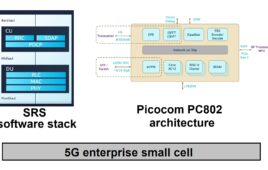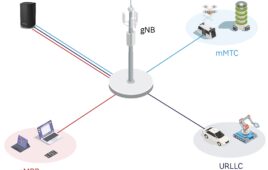As Qualcomm battled rival Broadcom’s hostile takeover bid earlier this year—probably the biggest threat to the company in its 33-year history—it continued to pour money into developing next generation 5G wireless technologies.
The aim was to speed up the rollout of ultra-fast 5G networks—where Qualcomm believes it has a lead on competitors.
“5G was supposed to be in 2020,” said Qualcomm President Cristiano Amon in an interview last week. “In the middle of the biggest crisis we’ve had, we maintained the level of research and development spending in order to accelerate 5G by more than a year.”
Now the question is will the maneuver pay off, or will it wind up being another misstep in what has been a rough two years for Qualcomm, San Diego’s largest publicly traded company.
Qualcomm barely escaped the clutches of Broadcom, surviving because of intervention by the Trump administration. It recently laid off more than 1,200 San Diego workers in a cost-cutting pledge aimed at appeasing frustrated investors.
For 21 months, it tried to acquire Dutch automotive chip-maker NXP Semiconductors, only to have the $43 billion deal derailed by Chinese regulators amid trade tensions with the U.S.
And it continues to fight legal attacks from Apple and antitrust regulators over its patent licensing practices, including a pending lawsuit from the U.S. Federal Trade Commission.
Regulatory fines and Apple’s refusal to pay patent royalties have marred Qualcomm’s financial results. Revenue last year fell nearly 3 percent to $22.3 billion. Earnings slid 57 percent to $2.5 billion.
With the Apple fight showing no signs of ending and the collapse of the NXP deal, Qualcomm is in reset mode.
But Amon said its strategy hasn’t changed. It is betting cellular technologies will expand into many new industries beyond smartphones. That, coupled with the roll out of 5G networks, will get the company back on track.
Qualcomm typically does well when the mobile industry upgrades to a new generation of technology. Revenue for its chip division doubled during the transition from third generation 3G networks to today’s 4G LTE.
“Because of Qualcomm’s early investments, we are going to see 5G launch in the United States as early as April 2019,” said Amon. “You are going to be able to buy a 5G phone.”
Network operators are committed to 5G, and they can achieve a critical mass of coverage relatively quickly by adding 5G equipment to existing cell towers, said Amon.
Qualcomm sees a world that is quickly becoming hyper-connected, with wireless technology expanding into connected cars, health care devices, smart cities and smart homes, automated factories and security systems.
“We spent the last 30 years connecting people. We will spend the next 30 years connecting things, said Brian Modoff, Qualcomm’s executive vice president for strategy and acquisitions, at a recent event. “The exciting thing for the company is we are leveraging what we are already good at.”
When Qualcomm set its sights on NXP in October 2016, it had relatively few customers outside of the smartphone market. Buying NXP would have opened sales avenues into NXP’s 30,000-plus customer base—diversifying Qualcomm’s business.
In the nearly two years since, however, Qualcomm has managed to expand its customer base on its own. It now totals 9,000—including 18 of the top 25 global auto brands, myriad Internet of Things companies, consumer electronics firms and Wi-Fi networking gear makers.
“We wanted NXP, but we didn’t sit still,” said Amon. “During those 21 months we had been waiting, we executed on that exact strategy to the point where we were able to generate $5 billion in (non-smartphone) revenue in the chip business—70 percent growth over those two years. That gives us confidence to continue the strategy because mobile is disrupting all these industries.”
With connected cars, Qualcomm has achieved a $5 billion order backlog—mostly in onboard navigation/entertainment and connectivity systems. It is working to redesign cockpits to bring more information to the dashboard, such as blind spot camera displays.
It is also working on technology that allows cars to communicate directly with nearby vehicles, smartphone carrying pedestrians, connected stoplights and other smart cities infrastructure.
“There is huge potential for this technology to be important for autonomous driving and safety,” said Amon.
5G will become the main fabric for this hyper-connected world, according to Qualcomm. In cities, it promises to deliver speeds approaching one gigabit per second for average users outdoors on a loaded network, compared with 4G LTE speeds under 50 megabits per second under the same conditions. It also will deliver imperceptible transmission delays.
Indoors and in rural areas, 5G will significantly boost speeds and add more capacity, but it probably will not reach the same level as in big cities—at least initially.
Amon said all of Qualcomm’s top-tier smartphone customers plan to release 5G Android phones next year. While adoption by users is hard to predict, Amon is optimistic.
“I have not met a person who does not want faster Internet,” he said. “You get a 4K display with a better camera and take a fantastic picture, you want to upload that as fast as possible and share it.”
“The second thing is the world has gone to unlimited data plans. An operator deploying a 5G network has a lower cost per bit. So there is an incentive to move the unlimited plans over to 5G.”
The emergence of 5G—which is more complex than 4G—also could propel Qualcomm’s efforts to supply more silicon to smartphones—especially power amplifiers, switches, antenna tuners and other radio frequency front-end components.
Despite these growth paths, the fight with Apple continues to weigh on the company.
Apple stopped paying patent royalties to Qualcomm more than a year ago. During a recent earnings conference call, Qualcomm said it no longer expects to supply cellular radio chips for upcoming iPhone models slated to be unveiled by Apple in an event on Sept. 12.
Amon said Qualcomm is forecasting “zero” chip sales into new iPhones for the next three years. Previously, Qualcomm supplied radio chips for about half of the iPhone 8s and iPhone X models globally, with Intel providing the rest.
“We are basically planning for zero because of this dispute,” he said. “We want stability in our company. Of course, it puts pressure for us to grow into all these new areas, and that is what we are doing.”
While the Apple fight rages on in courts worldwide, Qualcomm has made progress with some regulators and Samsung—the world’s largest smartphone maker.
The company reached a settlement with Taiwan’s anti-monopoly regulator that reduced a fine from more than $770 million to $93 million. The settlement also eliminated demands that Qualcomm change its patent licensing business model.
Samsung recently signed on to license Qualcomm’s entire patent portfolio including 5G—both standard essential and non-essential patents. Samsung withdrew its support for fines and business model changes imposed against Qualcomm by South Korea’s antitrust regulator, which Qualcomm is now appealing in court.
Qualcomm has created a new patent licensing framework. It includes 5G patents without raising rates, and allows device makers to license a smaller pool of patents at a reduced rate. It also caps the maximum amount device makers pay in royalties.
“We take issue with so many of the objections to the licensing practice,” said Alex Rogers, head of Qualcomm’s technology licensing arm. “They are high level accusations that when you look at the facts, the facts don’t support them. But aside from that, what is in the best interest of the licensing business is to just move away from the conflict, move away from the instability, because there is plenty of opportunity in front of us.”
If 5G turns out to be a hit next year—and if Qualcomm is correct that it has a technology lead over Intel and other competitors—that could create a path for a settlement with Apple, said Mike Walkley, an analyst with Canaccord Genuity.
“While Qualcomm is anticipating not shipping modems to Apple’s next generation smartphones launching later this year, we believe Apple will need to consider moving back to Qualcomm should it decide to launch 5G iPhones in the coming years,” said Walkley in a research note. “We believe this could help Apple and Qualcomm settle their lawsuits and reach a licensing agreement, especially given Qualcomm’s more transparent 5G licensing model.”



